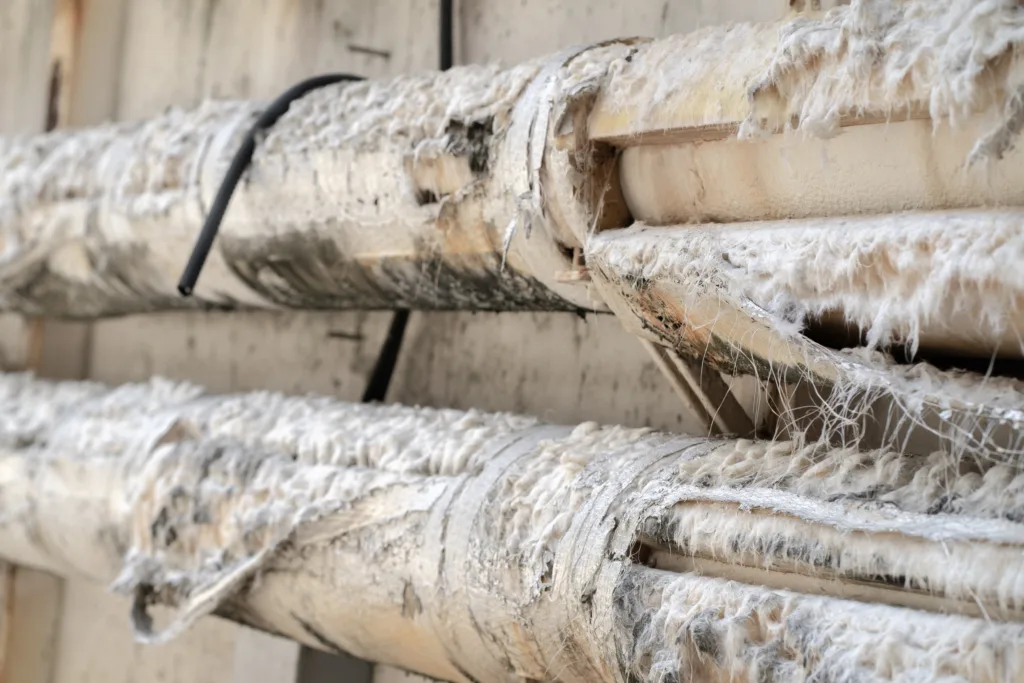Building materials, such as insulation for homes, offices, and other structures, once extensively used asbestos. Asbestos exposure can cause anything from relatively mild illnesses to catastrophic diagnoses. Since so many of us still live and work in older buildings, asbestos insulation is likely present.
However, while we no longer use asbestos to the same extent, property owners and real estate agents must recognize and detect materials that may have asbestos. Understanding how to protect yourself and others starts with knowing what it looks like, its common uses and locations, and why it poses serious health risks.
Navigating the intricate path to securing compensation in an asbestos exposure case demands the expertise of seasoned attorneys. Get in touch with an asbestos lawyer now to explore the best steps for your case.
What Does Asbestos Insulation Look Like?
Asbestos occurs naturally as a grayish, silver rock crystal with closely wound fibers underground or in mines. Once the industry mines, breaks down, colors, and manufactures asbestos with other materials like insulation, it is harder to identify.
Asbestos may look similar to many safe, modern alternatives, but it possesses characteristics that can help in its identification.

Identifying asbestos insulation
So, what does asbestos insulation look like? Typically, asbestos insulation’s texture is fairly distinct. It consists of coarse, tightly packed fibers that are often much denser than non-asbestos insulation and may have a more irregular texture.
Fibers of this type are strong and heat-resistant, making them ideal for many products and applications.
Although government officials have outlawed most uses of the mineral, no federal laws mandate property owners to disclose the presence of asbestos in a sale.
Inhaling dust from destroying or disturbing asbestos-containing materials through house renovations or other activities can cause deadly health problems. If you’re buying real estate or discover worn-down tiles, pipes, insulation, or other products, find a certified local asbestos testing company to test and verify contamination.
Common Types of Insulation That Contain Asbestos
There are many different kinds of insulation materials. Asbestos-containing thermal insulation includes spray-on, loose-fill, wrap, and block products. The construction and shipbuilding industries, as well as the automotive industry, often use these materials. Many companies have taken steps to phase out the use of asbestos-containing insulation and replace them with safer alternatives.
Loose-Fill Insulation
Many buildings use this fluffy, lumpy insulation material to fill hollow spaces in structures by pouring it on attic floors or blowing it into empty spaces.
The composition of loose-fill asbestos insulation makes it easily disturbed by the slightest wind, sending dangerous inhalable asbestos fibers into the air.
Insulation Wrappings
Insulation of this type was molded to insulate pipes, ducts, and other plumbing systems. As wrapped insulation ages, it can crumble, releasing asbestos dust into the air. This type of insulation was a major health hazard on Navy ships for decades.
Asbestos pipe insulation was often made of asbestos wool, which contains asbestos fibers that often disperse due to wear and tear.
Block Insulation
Block insulation looks like slabs or bricks but is entirely made of asbestos, making it particularly risky. These were often secured to the inside of the walls of buildings to insulate equipment, including boilers.
Blanket Insulation
Asbestos-containing blanket insulation was most prevalent between the 1930s and 1970s before the health risks of asbestos exposure became widely known and regulations were introduced. After this period, manufacturers largely stopped using asbestos in insulation products in the U.S.
Blanket insulation is a type of thermal insulation commonly used in residential, commercial, and industrial buildings. It typically comes in large rolls or precut panels and is designed to fit between the framing elements of a building, such as studs, joists, or rafters as attic insulation.
Spray-on Insulation
Companies might apply spray-on asbestos to large steep beams, ceiling boilers, furnaces, and other heat-generating equipment. It is common in industrial and commercial buildings and is one of the most dangerous types because it is readily released into the environment when touched.
The U.S. bans spray-on insulation containing more than 1 percent asbestos without a bituminous or resinous binder.
Asbestos is likely present in older houses built before 1980 unless testing proves otherwise. Professional testing is the only way to determine whether the insulation is safe.
Cellulose Insulation vs. Vermiculite Insulation
Cellulose insulation and vermiculite insulation are two different types of insulation materials, but both have been linked to potential asbestos exposure under certain conditions.
Cellulose Insulation
Cellulose insulation is made primarily from recycled paper products, such as newsprint, treated with flame-retardant chemicals like boric acid. It is commonly used as loose-fill insulation in attics and walls. Generally, cellulose insulation does not contain asbestos because it is made from organic materials.
However, contamination could occur if cellulose insulation was installed in older homes that already had asbestos-containing materials (ACMs), such as insulation boards or pipe wrappings. Disturbing these materials during installation could lead to asbestos exposure. While modern cellulose insulation is considered safe and free from asbestos, care should be taken in older homes where asbestos materials may be present nearby.
Vermiculite Insulation
Vermiculite insulation, on the other hand, is a lightweight, naturally occurring mineral often used as loose-fill insulation, particularly in attics. It expands when heated, making it an effective insulator. It was marketed under brand names like Zonolite in the mid-20th
Although vermiculite does not naturally contain asbestos, a large proportion of the vermiculite used in insulation in the U.S. came from a mine in Libby, Montana, which was contaminated with asbestos. As a result, most vermiculite insulation produced before 1990 often contains asbestos fibers.
There is a high risk of asbestos exposure if vermiculite insulation is disturbed (e.g., during renovations or demolition), releasing fibers into the air. Vermiculite insulation should be treated as asbestos-containing unless proven otherwise through testing.
Key Precautions for Both Types
- Do Not Disturb: Avoid handling or disturbing insulation materials in older homes, especially loose-fill types like vermiculite. This can release microscopic fibers that can be inhaled or ingested, posing severe health risks.
- Testing: If you suspect insulation may contain asbestos, have it tested by a certified asbestos professional like a licensed asbestos contractor.
- Professional Removal: If asbestos is detected, hire licensed abatement specialists for safe removal.
Asbestos Wool Insulation vs. Rock Wool Insulation
Asbestos wool insulation and rock wool insulation are not the same. They may look somewhat similar in certain forms, as both materials consist of fibrous textures designed for insulation. However, there are important differences in their appearance, composition, and handling recommendations.
Asbestos wool insulation was made primarily of asbestos fibers, which were valued for their heat resistance, fireproofing capabilities, and insulating properties. It was often used in high-temperature industrial applications or older residential insulation. It is highly hazardous.
Rock wool insulation (also called mineral wool) is made from naturally occurring minerals like basalt or diabase, or from industrial by-products like slag. It is produced by heating these materials to high temperatures and spinning them into fibers, much like cotton candy.
It is commonly used for thermal and sound insulation in residential, commercial, and industrial buildings, and for fireproofing because it is non-combustible.
Early versions of rock wool (produced before modern standards) could irritate the skin or respiratory system due to the presence of fine fibers, but these do not pose long-term health risks like asbestos. Modern rock wool complies with health and safety standards and is widely considered safe to use.
Visual Inspection
Rock wool insulation is typically gray, brown, or off-white, depending on the materials used (e.g., basalt or slag). It is fibrous and slightly coarse, with visible strands that resemble compacted wool. Found in woven insulation batts, rolls, or loose-fill insulation.
Asbestos wool insulation is often white, gray, or off-white, though aging can cause discoloration. It is fibrous but finer and softer than rock wool, with a more uniform appearance. It is commonly found as loose fill or wrapped around pipes, boilers, and ducts.
Visually, it can be difficult to distinguish between the two materials, especially if the insulation is old or degraded. Both can appear dusty or compacted after years of use, further complicating identification. If you are working in a home or building constructed before the 1980s that contains wool-like insulation, the best bet is to treat it as though it may contain asbestos and call a professional to inspect it.
The Health Risks of Asbestos Exposure
An asbestos-containing product contains more than 1 percent of asbestos minerals. Whenever asbestos fibers get inhaled, they can get stuck in the lungs and irritate the tissues inside. The more asbestos exposure you have, the greater the risk of developing asbestos-related diseases.
However, prolonged exposure is not necessary to make asbestos insulation dangerous. Any contact with the fine fibers from asbestos insulation can have a negative impact on human health.
A person who breathes asbestos can develop non-cancer diseases. For example:
- Asbestosis usually occurs in people with long-term asbestos exposure. In asbestosis, the lungs become scarred due to breathing in asbestos fibers. Symptoms of asbestosis may not appear for years.
- Pleural disease is a non-cancerous lung condition that affects the membrane surrounding the lungs and chest cavity. Although not all people with pleural changes suffer from breathing problems, some may have less efficient lung function.
Cancers from asbestos exposure include:
- Lung cancer – A malignant tumor that invades and blocks the lung’s airways. Asbestos exposure and smoking tobacco significantly increase the risk of lung cancer.
- Mesothelioma – A rare cancer caused only by asbestos exposure. This cancer can attack the membranes that cover the lungs and chest cavity, the membrane lining the abdomen, or the membranes surrounding internal organs. A person exposed to asbestos may not show signs of mesothelioma for 30 to 40 years.
Asbestos exposure can also cause cancer of the larynx, ovaries, pharynx, stomach, and colorectum. Educating yourself about the dangers of asbestos exposure and the likelihood of asbestos being present on your property is the only way to stay safe.
For proper asbestos testing and removal, call a professional and never attempt to test asbestos insulation yourself, as you can spread the fibers and endanger yourself.
Contact An Asbestos Lawyer For Help
The long and complex road to retrieving compensation in a case involving asbestos exposure requires guidance from the right attorneys. They can recover the compensation you need for the necessary medical treatment.
If you or a loved one is facing the devastating effects of mesothelioma or another asbestos-related disease, you don’t have to navigate this difficult journey alone. The path to compensation can be complex, but an experienced asbestos attorney can help you pursue the justice and financial support you need for medical care and other expenses.
Take the first step toward securing your future. If you need help filing a claim, contact an asbestos injury lawyer today for a free case evaluation and personalized guidance on your options. We are ready to discuss your options for moving forward. Call us at 312-466-1669 or click the button below to fill out an online contact form.



